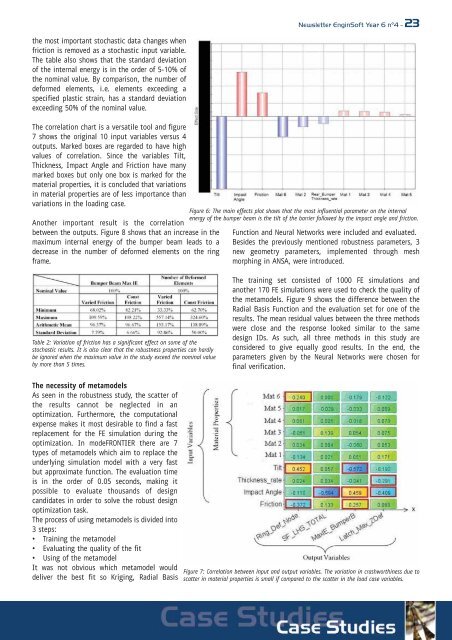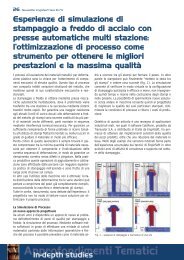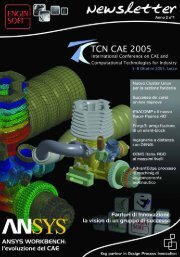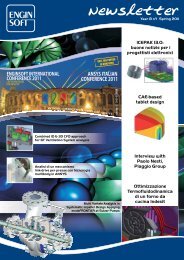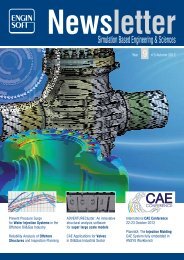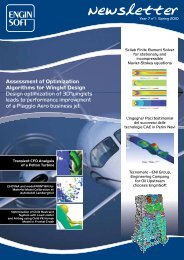software training courses 2010 corsi di addestramento ... - EnginSoft
software training courses 2010 corsi di addestramento ... - EnginSoft
software training courses 2010 corsi di addestramento ... - EnginSoft
You also want an ePaper? Increase the reach of your titles
YUMPU automatically turns print PDFs into web optimized ePapers that Google loves.
the most important stochastic data changes when<br />
friction is removed as a stochastic input variable.<br />
The table also shows that the standard deviation<br />
of the internal energy is in the order of 5-10% of<br />
the nominal value. By comparison, the number of<br />
deformed elements, i.e. elements excee<strong>di</strong>ng a<br />
specified plastic strain, has a standard deviation<br />
excee<strong>di</strong>ng 50% of the nominal value.<br />
The correlation chart is a versatile tool and figure<br />
7 shows the original 10 input variables versus 4<br />
outputs. Marked boxes are regarded to have high<br />
values of correlation. Since the variables Tilt,<br />
Thickness, Impact Angle and Friction have many<br />
marked boxes but only one box is marked for the<br />
material properties, it is concluded that variations<br />
in material properties are of less importance than<br />
variations in the loa<strong>di</strong>ng case.<br />
Another important result is the correlation<br />
between the outputs. Figure 8 shows that an increase in the<br />
maximum internal energy of the bumper beam leads to a<br />
decrease in the number of deformed elements on the ring<br />
frame.<br />
Table 2: Variation of friction has a significant effect on some of the<br />
stochastic results. It is also clear that the robustness properties can hardly<br />
be ignored when the maximum value in the study exceed the nominal value<br />
by more than 5 times.<br />
The necessity of metamodels<br />
As seen in the robustness study, the scatter of<br />
the results cannot be neglected in an<br />
optimization. Furthermore, the computational<br />
expense makes it most desirable to find a fast<br />
replacement for the FE simulation during the<br />
optimization. In modeFRONTIER there are 7<br />
types of metamodels which aim to replace the<br />
underlying simulation model with a very fast<br />
but approximate function. The evaluation time<br />
is in the order of 0.05 seconds, making it<br />
possible to evaluate thousands of design<br />
can<strong>di</strong>dates in order to solve the robust design<br />
optimization task.<br />
The process of using metamodels is <strong>di</strong>vided into<br />
3 steps:<br />
Training the metamodel<br />
Evaluating the quality of the fit<br />
Using of the metamodel<br />
It was not obvious which metamodel would<br />
deliver the best fit so Kriging, Ra<strong>di</strong>al Basis<br />
Newsletter <strong>EnginSoft</strong> Year 6 n°4 - 23<br />
Figure 6: The main effects plot shows that the most influential parameter on the internal<br />
energy of the bumper beam is the tilt of the barrier followed by the impact angle and friction.<br />
Function and Neural Networks were included and evaluated.<br />
Besides the previously mentioned robustness parameters, 3<br />
new geometry parameters, implemented through mesh<br />
morphing in ANSA, were introduced.<br />
The <strong>training</strong> set consisted of 1000 FE simulations and<br />
another 170 FE simulations were used to check the quality of<br />
the metamodels. Figure 9 shows the <strong>di</strong>fference between the<br />
Ra<strong>di</strong>al Basis Function and the evaluation set for one of the<br />
results. The mean residual values between the three methods<br />
were close and the response looked similar to the same<br />
design IDs. As such, all three methods in this study are<br />
considered to give equally good results. In the end, the<br />
parameters given by the Neural Networks were chosen for<br />
final verification.<br />
Figure 7: Correlation between input and output variables. The variation in crashworthiness due to<br />
scatter in material properties is small if compared to the scatter in the load case variables.


